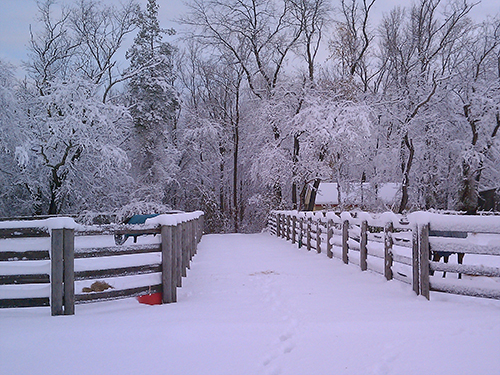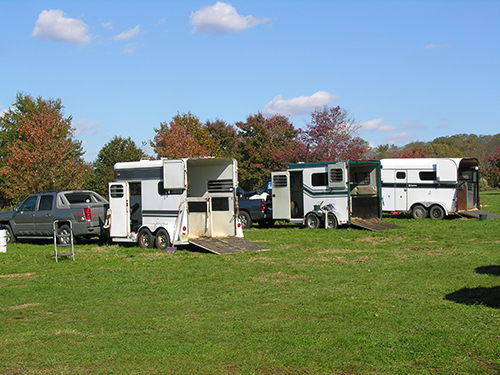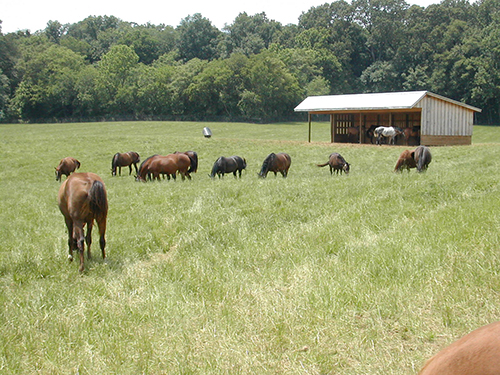
Fact Sheet FS656
What is Stress?
Stress is the body's response to anything that it considers threatening. For a horse this could be anything from trailering and traveling, showing, poor nutrition, feeding at irregular times, changes in other routines, environmental toxins, interactions within their social environment, variations in climate, and illness.
Some types of stress include various physical stresses that are based on the physical makeup of the animal, and its ability to respond to changes in diet, injury, etc. Psychological stresses are based on a horse's personality and its perception of life. For example, some horses are more stressed by being in a stall for longer periods of time than others.
The horse's basic stress response starts with a change in behavior, either by moving away from a stimulus, swishing its tail, bucking, tensing up, etc. This stress will then cause activation of the sympathetic nervous system, called the "Fight or Flight" response. The sympathetic nervous system will create an involuntary action of the intestines (diarrhea), endocrine glands (production of adrenaline and cortisol), and heart (increase in heart rate). Next the neuroendocrine system will be activated allowing the horse's system to increase its energy utilization.
Each horse deals with stress in a different way depending on the personality of the individual horse.
Demonstrative, Confident Horse
- Lets you know when it is stressed!
- Bucks, kicks, bites, is very curious, mouthy, a troublemaker, etc.
Demonstrative, Fearful Horse
- Worries about everything!
- Shies the first time it sees things and needs time to relax.
Passive, Confident Horse
- Usually wonders what everyone's worried about?
- Not normally stressed, internalizes stress, shows little change even when stressed.
- This horse usually is the last one in the field to take off running if something runs out of the woods.
Passive, Fearful Horse
- Wants to please!
- This horse seems willing to do anything but will tighten muscles and lips when stressed.
- This horse won't show fear until pushed over the limit.
Heat Stress
During exercise heat production will increase up to 50%. This can create a problem when exercising under extremely hot and humid conditions. In response to heat stress the horse will increase its sweating rate, move a large portion of their blood flow to capillaries under the skin, and increase its rate of respiration (may be over 20 breaths per minute in a resting horse) to help in the cooling process. Some horses will have a condition called "anhidrosis,"" which is when the horse lacks the ability to sweat. This makes their coat feel very hot yet dry. The horse’s number one way to cool down is through evaporation; when it does not sweat, it cannot use this method of cooling, and the risk of overheating is even greater! Another way horses will show heat stress is with an increase in resting heart rate. At rest, the normal range of heartbeats should be between 28 and 36; however, when heat stressed it can be over 50. Internal rectal temperature will also be elevated to 104 degrees F or higher.

Figure 1. Cooling down a horse with cold water after exercise.
When treating heat stress, the first thing you will need to do is move your horse to a shady area. Provide fans, wind, or other forms of ventilation; this will help with the evaporation process. Spraying the horse with cold water, specifically the legs and abdomen, will also help in this process because the veins and arteries lie just below the skin and can rapidly cool blood flowing to internal organs. Allow the horse to drink small amounts of water frequently and provide electrolytes to replace those lost by excessive sweating. In severe cases you should contact a veterinarian immediately. Cold-water enemas will probably be administered, and the horse will be treated for dehydration.
Once a horse overheats it is much more likely to overheat again, so preventing heat stress before it is ever a problem is extremely important. One way to help prevent heat stress is to provide regular electrolytes in hot weather, especially if training hard where the horse may lose a lot of sweat. Increasing the amount of fat in the diet will allow you to decrease the amount of grain you need to feed, while keeping the energy density of the feed high. Decreasing the grain will decrease the amount of heat produced during digestion. Always cool horses down properly after exercise allowing plenty of time and ventilation. Avoid riding in extreme heat and humidity, if possible.

Figure 2. Horses outdoors in the winter months should be allowed free choice grass hay to help stay warm.
Cold Stress
Horses fight cold weather by using more energy to stay warm. As a rule, a 1% increase in energy requirements is needed to replace energy loss from the cold weather for each degree the temperature falls below the horse's critical temperature. Critical temperature is the temperature below which a horse starts to expend additional energy to provide warmth. This temperature for individual horses will vary because of fat cover, hair thickness, acclimatization of the horse to cold, hair-coat wetness and wind-chill. For example, if you have a horse that is clipped during the winter months, they will have a much higher critical temperature and will have to be blanketed to help it thermoregulate. You can tell if a horse is losing too much heat if snow melts on its back instead of accumulating on top of their hair; shivering can also be an indication. For more on winter care and winter feeding see Rutgers Cooperative Extension publications FS1142, Winter Care for Horses and FS1143, Winter Feeding for Horses.

Figure 3. Horse with a blanket in the cold winter months.
To help our horses decrease their critical temperature one needs to precondition them for cold weather. Making sure horses carry enough weight to use as energy and insulation is a good way to go into winter. Provide free choice grass hay during the winter months, which will allow the horses to always be producing enough internal heat while the gastrointestinal tract is fermenting the hay. Providing shelter from wind, rain and cold is important and if you have a horse that is not allowed in the shelter with other horses it is a good idea to provide a blanket, especially when there is freezing rain. Be sure blankets are waterproof. A wet blanket may cause a horse to lose more heat than if the horse was not blanketed. For more on blanketing horses in the winter see Rutgers Cooperative Extension publication FS1081, To Blanket or Not to Blanket?.
Transport Stress
Below are some reasons why transporting can be stressful to your horse:
Psychological Factors
- Separation from the herd
- Exposure to strange animals and environment
Health Factors
- Dehydration
- Fatigue from constant balancing
Climatic Factors
- High internal temperature and humidity
Physical Factors
Shipping Fever is a respiratory disease that develops during or shortly after a trip. A primary factor in shipping fever is suppression of the immune system due to the trip's stress. Other than shipping fever, transportation stress can also cause a decrease in fluid intake leading to dehydration, loss of appetite, hypocalcaemia (low Ca) or hypomagnesaemia (low Mg), weight loss, dust inhalation and coughing, diarrhea, and possibly exertional rhabdomyolysis.
Studies in the past decade have investigated numerous factors during transport to try and make a horse's haul more comfortable. Some of these factors include orientation of the horse in the trailer during transport, design of the suspension and ventilation of the trailer, quality of the transport environment and air quality, and generally the amount of stress a horse is under during various lengths of hauls. Most studies have shown that levels of the stress hormone, cortisol, increase during transportation along with an increase in heart rate variability (HRV), which is a brief increase or spike in heart rate. Some studies have reported as much as a 6% weight loss during a 24 hr haul. Half of this weight was replaced over a 24 hr recovery period. Muscle enzymes called creatine kinase and aspartate aminotransferase (CK & AST) leak out of the muscle after a 24-hr. haul. This is a potential indicator for muscle damage.

Figure 4. A trailer with plenty of ventilation.
To decrease transportation stress, it is recommended to keep your total travel time under 12 hours. If this is not possible you should plan overnight stops where you can unload your horse and allow it to rest. It is also recommended to stop every 3 to 4 hours to offer the horse's legs a break from the vibration and provide water every 6 to 8 hours of the trip. Cleaning the trailer thoroughly after each use will decrease the amount of dust inhaled. It is also a good idea to leave your horse’s head untied or tied loosely to allow them to lower their heads if they need to cough. Always leave a trailer window or vent open to allow for better ventilation (pictured right). Horses are much more tolerant of the cold than they are of dust. It is always a good idea to give a horse a few days to recover after arriving at the destination. If you are concerned about shipping fever you can monitor daily rectal temperatures, which will help you detect a problem before it gets serious. On long hauls, especially, it is a good idea to provide things that are comfortable to the horse, for example their usual hay, water, grain, or bedding.
Are dietary adjustments necessary before hauling a horse? Many people use bran mashes before transporting horses, however there is no benefit in doing this. Bran mashes are what nutritionists call a "comfort food." They make owners feel like they did the right thing for their horse, yet they are not proven to have any benefit. Before long hauls during competition, it is a good idea to put your horse on a vitamin E supplement to help them cope with the stress. Also giving them vitamin C (7 to 10 grams) the day of and 2 to 3 days after transport can help reduce the risk of shipping fever. It is a very good idea to vaccinate your horses against respiratory disease at least 2 weeks before traveling and remember to never ship a sick horse long distance. Also allow plenty of time for your trip in case of emergencies; this will also decrease stress in the life of the person doing the transporting!
Oxidative Stress
During oxidative metabolism, about 98% of the oxygen consumed forms water and CO2, however, about 1 to 2% of the oxygen is not completely reduced and instead forms reactive oxygen species (ROS; intermediates formed during metabolism of oxygen). These ROS produce harmful effects and can degrade proteins, DNA and fatty acids that make up equine cells. Some of these ROS include hydrogen peroxide (H2O2), singlet oxygen (1O2), and free radicals (an ROS with an unpaired electron).
Antioxidants are the body's way of combating the negative effects of the ROS. Oxidative stress occurs when the body's antioxidants are overwhelmed by production of ROS. Some common antioxidants include vitamin E, vitamin C, beta-carotene, glutathione, lipoic acid, selenium, cysteine, glutathione peroxidase, etc. Antioxidant supplementation may be needed during times of stress that have been associated with an increase in oxidative stress. These include intense exercise, rapid growth, reproduction, transportation, illness, or other types of stressful situations talked about earlier. When supplementing antioxidants, mixtures usually work best. It is important to avoid over-supplementation since some of the antioxidant vitamins and minerals can be toxic to the system in extremely high doses and should be avoided. For more information on the use of antioxidants in a horse's diet see Rutgers Cooperative Extension publication 1065, Antioxidants and Your Horse.
Stomach Ulcers
Are you giving your horse an ulcer? Did you know that 80–90% of all racehorses have ulcers? Also 60% of all performance horses (including eventers, jumpers, and western performance events), and 30–40% of all dressage horses develop ulcers.
A horse's stomach secretes acid even when they are not eating, unlike in humans. However, only half of their stomach is protected against damage from the acid. When a horse grazes all day, the roughage helps absorb the acid and the saliva produced neutralizes acid. Ingestion of a grain meal increases ‘gastrin,' which is a hormone that stimulates acid secretion. Therefore, it is important to always feed forage along with a grain meal. The main causes of stomach ulcers are a change in eating behavior, changes in management, or an increase in training intensity. Horses that are accustomed to being outside can develop ulcers after only 1 week after being kept in a stall; some horses could develop them as early as 24 hours.
Some signs that a horse is developing ulcers include a change in their attitude, poor appetite, colic, decreased performance, decrease in body condition, weight loss, and a dull or sour attitude. To prevent ulcers, you need to prevent stress; also minimize the use of non-steroidal anti-inflammatory agents (NSAID) like phenylbutazone (Bute).
Exertional Rhabdomyolysis (ER)
Other terms for ER are Tying-up, Azoturia, or Monday Morning Sickness. This condition is muscle pain and cramping associated with exercise. Its main prevalence is in the middle gluteal or semitendinosus muscles of the hindquarters. There are sporadic or chronic forms of ER, and it could be severe enough to decrease performance or be career-ending. There are different causes of tying-up for different breeds, however recurrent ER (RER) primarily affects Thoroughbreds, Standardbreds, and Arabians. Nervous two-year-old fillies are most severely affected; due to the stress associated with their training regime. With these horses the incidence may increase in severity as fitness increases.
One way to test for ER is to take a blood sample after exercise and have the sample analyzed for CK and AST (the muscle enzymes discussed earlier). These enzymes will be drastically elevated during a bout of ER and may even be elevated at rest in a horse that chronically ties up. The clinical signs that your horse is tying-up include stiffness of gait, specifically in the hind legs, unwillingness to move, and sensitive to touch in the affected muscles, which will feel very tight or tense. In severe cases the horse's urine will be a brown or reddish color from the breakdown and excretion of the myoglobin in the muscle.
To treat a horse inflicted with ER, immediately move it to a box stall and call a veterinarian. Blanket the horse if the weather is cool or hose the horse to remove sweat if the weather is warm. Check for signs of dehydration using the skin pinch test and look at their mucous membranes. Allow the horse small frequent sips of water when horse is hot and free access to water when horse is cool. Many other factors can contribute to tying-up. However, to help decrease the incidence of the disease attempts should be made to decrease training induced stress. Dietary changes and vitamin E supplementation may also help in some cases. For more information on the different types of tying up in horses see the NJAES factsheet 1277, Tying-Up in Horses.
Summary to Minimize Stress in Your Horse's Life
References and Other Recommended Reading
Photo credit: C. Williams, Equine Extension Specialist, Rutgers University
October 2024
Copyright © 2025 Rutgers, The State University of New Jersey. All rights reserved.
For more information: njaes.rutgers.edu.
Cooperating Agencies: Rutgers, The State University of New Jersey, U.S. Department of Agriculture, and Boards of County Commissioners. Rutgers Cooperative Extension, a unit of the Rutgers New Jersey Agricultural Experiment Station, is an equal opportunity program provider and employer.





